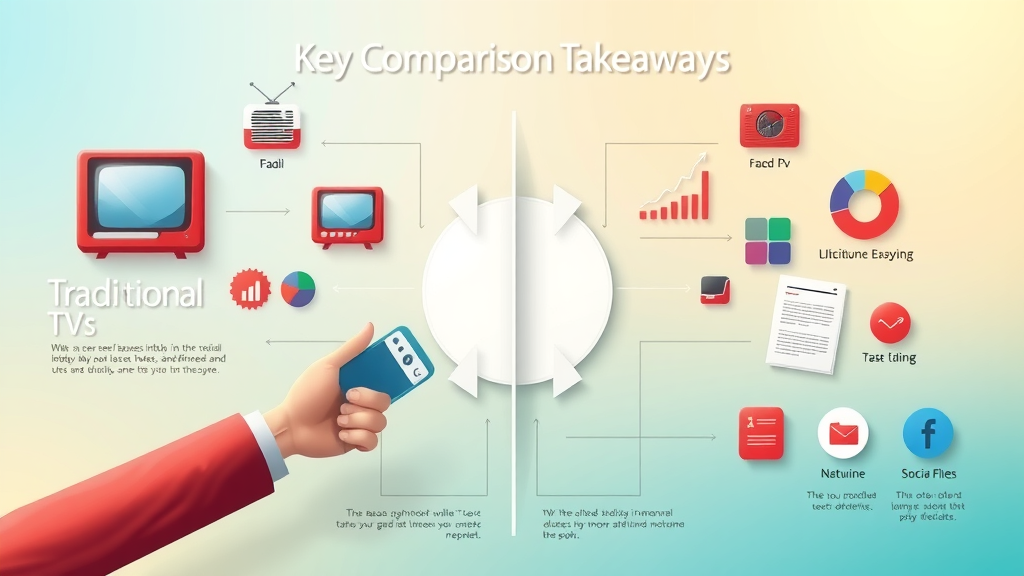In today’s rapidly evolving marketing world, selecting the right medium is more important than ever. Should your focus be on the time-tested reach of newspapers and TV commercials, or is it the instant measurability and targeting of digital ads that hold the key to growth? This article dives deep into traditional vs digital media , equipping you with real-world insights and the latest trends to fuel your marketing success today.

Understanding Traditional vs Digital Media: Definitions, Evolution, and Key Differences
- Definitions: Traditional media encompasses long-standing methods of mass communication such as newspapers, magazines, radio, and television. Digital media , meanwhile, refers to content distributed via the internet and digital platforms — think websites, social media, email, online video, and search engines.
- Historical evolution: Traditional media began dominating communication in the 20th century, offering businesses a powerful way to broadcast messages to broad audiences. The digital revolution, starting in the late 20th and exploding in the 21st century, disrupted this model. Suddenly, communication became two-way and highly interactive.
- Key differences today: Traditional media still commands authority and broad reach, often delivering high-impact brand recognition through TV spots or print ads. Digital media, on the other hand, thrives on precision, instant feedback, and adaptability — it allows real-time engagement, granular targeting, and cost-effective experimentation. Understanding these contrasts is crucial for building an agile and effective marketing strategy.
The Pros and Cons of Traditional vs Digital Media for Businesses
| Traditional Media | Digital Media | |
|---|---|---|
| Reach | Broad, mass audiences; high in local/regional areas | Highly targeted, global potential; niche segmentation |
| Cost | Higher initial investment (ad production & placement) | Flexible budgets; pay-per-click, scalable campaigns |
| Targeting Capabilities | Limited targeting; based largely on channel demographics | Advanced targeting (age, location, behavior, interests, etc.) |
| Measurement | Difficult to measure results quickly or accurately | Instant analytics; clear, real-time ROI tracking |
| Flexibility | Less adaptable once campaigns go live | Easy to optimize, edit, or pause campaigns instantly |

Audience Reach and Engagement: How Traditional vs Digital Media Stack Up
Demographic reach: Who does each medium serve best?
Traditional media — such as TV, radio, and print — often delivers exceptional reach with older demographics who are accustomed to consuming media in these formats. Local newspapers, for instance, are still staples in many communities, and television holds strong with 50+ audiences. Digital media , by contrast, excels with younger generations who are “digital natives.” Social media, influencer partnerships, search engines, and apps are particularly effective for Millennials and Gen Z, who crave immediate access and customization.
If your target market spans several age groups, integrating both types can maximize your reach. For example, a hybrid campaign might use print or broadcast to establish brand trust among older segments while deploying targeted Facebook or Instagram ads to engage younger, tech-savvy buyers.
It’s also worth considering that urban, educated, and higher-income groups are statistically more active on digital channels, while rural and traditionalist groups may still rely on classic media. Smart marketers study their audience data closely to make the right allocation.
Engagement levels: Interaction, feedback, and personalization in traditional vs digital media
When it comes to engagement , digital media leads the way with real-time interactions. Think: comments on posts, shares, likes, and personalized recommendations based on browsing habits. This immediate feedback loop empowers brands to iterate messaging, answer questions, and foster relationships instantly.
Traditional media tends to be one-way — audiences passively receive content, with limited direct communication or feedback. While a TV ad or billboard can spark awareness and conversation, the brand may never know if — or how — an individual was influenced. However, these formats can be powerful for broad emotional storytelling, brand-building, and campaigns that need mass, undivided attention.
Ultimately, digital offers unmatched flexibility for testing and personalization, while traditional delivers authority and scale. Savvy strategies use both to move consumers from awareness to action.
Measuring ROI: Analytics and Effectiveness in Traditional vs Digital Media Campaigns
- Tracking effectiveness: One of the starkest differences between traditional vs digital media lies in tracking outcomes. With digital campaigns , marketers can measure impressions, clicks, conversions, and cost per action in real time. Traditional campaigns (like TV or print) rely on broader indicators: reach, frequency, and post-campaign brand lifts — often requiring market research or phone surveys.
- Tools and platforms: Google Analytics, Facebook Insights, and marketing automation tools provide detailed analytics for digital channels, while traditional campaigns might be tracked using Nielsen ratings or circulation audits.
- Case studies and statistics: Brands report, on average, a higher ROI for digital ad spend due to precision targeting and measurable performance. Nevertheless, many studies highlight that multichannel campaigns — harnessing the strengths of both — can drive superior results, boosting recall, response, and loyalty.

Cost Considerations: Budgeting for Traditional vs Digital Media in 2024
- Cost breakdowns: Traditional media is often pricey up front. TV spots and full-page magazine ads can run into thousands of dollars per placement. Print design, distribution, and broadcast fees add up fast. Digital media, by comparison, allows for smaller, more flexible budgets — businesses can start with just a few dollars a day and scale with results.
- Long-term vs short-term investments: Traditional channels typically require longer commitments but may deliver extended exposure and brand prestige. Digital can be quickly adjusted or paused, ideal for dynamic brands or campaigns seeking quick wins.
- Factors impacting cost-effectiveness: The actual ROI depends on targeting precision, creative quality, and the appropriateness of the channel for your audience. Using the right balance of traditional vs digital media ensures that spending aligns directly with business goals and measurable outcomes.
Current Trends: How Media Consumption Habits Are Shaping Traditional vs Digital Media
- Latest statistics: Data shows that North Americans now spend nearly 8 hours a day on digital devices, with 77% of adults active on at least one social media platform. Streaming video and on-demand content are surging, while newspaper and terrestrial TV consumption trend downward, especially among under-40 audiences.
- Mobile, video, and social trends: Mobile usage dominates, with over half of all web traffic now coming from smartphones. Video is king, driving engagement on platforms like YouTube, TikTok, and Instagram Reels. Social channels foster direct dialogue and viral potential, making them essential for contemporary marketing.
- The enduring niches for traditional media: Despite these shifts, certain traditional media avenues — such as local radio, specialty magazines, and event sponsorships — maintain influence, especially in older, rural, or professional segments. A strategic mix ensures businesses don’t miss valuable audience pockets.

"The future belongs to brands that skillfully blend the credibility of traditional media with the precision and agility of digital — meeting audiences wherever they live, work, and play." — Media Industry Expert
Choosing the Right Mix: When to Use Traditional vs Digital Media in Your Strategy
- Steps for evaluating your business needs:
- Define clear marketing objectives and KPIs
- Analyze your target audience (demographics, habits, media use)
- Assess your resources and creative capabilities
- Key considerations for building an integrated strategy:
- Leverage traditional media for credibility, awareness, and mass reach
- Utilize digital media for targeting, quick feedback, and personalization
- Align timing, messaging, and creative across both for consistency
- Examples of successful hybrid campaigns:
- A national retailer launches a new product with television teasers, then drives viewers online with exclusive web content and targeted social ads
- An automotive brand combines print magazine features with QR codes linking readers to digital test drive scheduling

Frequently Asked Questions about Traditional vs Digital Media
- What are the main differences between traditional and digital media? Traditional media offers broad, one-way reach (TV, print, radio), while digital media allows two-way interaction, precise targeting, and rapid analytics (web, social, email).
- Is traditional media still effective in 2024? Yes! For certain audiences and markets, especially older or local demographics, traditional media maintains strong brand authority and recognition.
- How do I decide which is best for my business? Evaluate your goals, target audience habits, budget, and the type of message you want to deliver. Often, a blend of both achieves optimal results.
- Can traditional and digital media work together? Absolutely! Integrated campaigns tend to deliver stronger awareness, higher engagement, and better ROI by reaching audiences across multiple touchpoints.
Key Takeaways for Marketers Comparing Traditional vs Digital Media

- Actionable summary points:
- Traditional media offers unmatched authority and broad awareness, but digital excels in engagement and measurability.
- Knowing your audience’s habits is essential to allocate your marketing budget wisely.
- Embrace data-driven digital tactics for ongoing optimization, but don’t abandon traditional methods that still resonate in your market.
- Integrated strategies produce the highest ROI and customer loyalty — bridge classic and online approaches for optimal impact.
- Tips for immediate application:
- Audit your current campaigns for cross-channel opportunities.
- Experiment with digital tracking even on traditional assets (e.g., custom URLs or QR codes in print ads).
- Stay current with media consumption trends — today’s winning mix may shift tomorrow.
Make Your Marketing Work: Next Steps with Traditional vs Digital Media
"Embrace the evolution of media — innovation begins when you connect the best of both worlds to create compelling campaigns that truly resonate."
Ready to Grow Your Business? Book your free marketing strategy session.
Leverage the strengths of both traditional and digital media to accelerate your marketing results. Contact us today for a tailored, actionable strategy that delivers.
In the evolving landscape of marketing, understanding the distinctions between traditional and digital media is crucial. The article “Traditional vs. Digital Marketing” from the Altera Institute provides a comprehensive analysis of both approaches, highlighting their respective advantages and limitations. Similarly, “Digital Marketing vs Traditional Marketing – Key Differences” by Landingi delves into the cost efficiency and targeting capabilities inherent in digital strategies compared to traditional methods. For a broader perspective, “Traditional Media vs. New Media: Differences & Which Methods To Use” from WebFX explores the distribution channels and audience interaction unique to each medium. If you’re serious about optimizing your marketing strategy, these resources will offer valuable insights into balancing traditional and digital media effectively.
 Add Row
Add Row  Add
Add 



Write A Comment